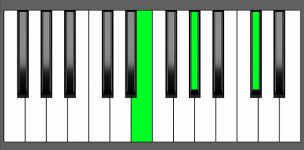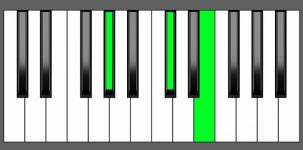Piano Diagram of Db min in Root Position

The Db minor chord is the minor triad built upon the D-flat key. It is built by combining the Root note (Db), the minor 3rd (Fb, which is equivalent to E), and the 5th (Ab) notes from the D-flat minor scale.
Structure of Db minor
Notes |
|---|
| Db, Fb, Ab |
Intervals |
|---|
| R, m3, 5 |
Fingers Position
Left Hand |
|---|
| 4, 2, 1 |
Right Hand |
|---|
| 1, 2, 4 |
Db minor Chord Inversions
The Db minor chord has a total of 2 inversions:
| Root Position: | Db | Fb | Ab |
| 1st Inversion: | Fb | Ab | Db |
| 2nd Inversion: | Ab | Db | Fb |
Piano Keyboard Diagrams
Music Theory and Harmony of Db minor
What are Minor Chords?
Minor chords are one of the two most important types of chords in music, along with the major chord. Minor chords are triads that have a slightly different sound from major chords. They have a darker and more melancholic sound compared to major chords, which have a brighter and more uplifting sound. The difference lies in the 3rd note of the chord – minor chords use a minor 3rd while major chords use a major 3rd.
Despite their darker sound, minor chords are still considered stable and consonant chords. This means that they do not create a sense of tension or dissonance that requires resolution, unlike some other types of chords such as dominant 7th chords or diminished chords.
Building the Db minor Chord: Different Approaches
Starting from the Db major scale
To form a Db minor chord, three notes are required: the root, minor 3rd, and 5th of a minor scale. However, since Db minor is a theoretical key, it’s not commonly used due to the many accidentals involved. Instead, it’s easier to use the Db major scale, as it better illustrates the relationship between intervals and their qualities.


To build a minor chord, you can apply the formula R, m3, 5 using these step-by-step instructions:
- Begin with the Root note, Db.
- To select the minor 3rd interval of a note, you need to count three half steps up from that note. Alternatively, you could find the 3rd note on the major scale (which for Db would be F) and then lower it down by a half step to arrive at the note Fb (E), which is the minor 3rd interval of Db.
- Finally, add the 5th interval, which is Ab.
This formula can be applied to any major scale to create a minor chord with a different root note.
by Combining Intervals
A minor chord is created by combining two specific intervals: a minor 3rd and a major 3rd.
m3 + 3 = minor Chord
To form a Db minor chord, begin with the root note Db and add a minor 3rd interval. This interval consists of three half-steps, so count up three half-steps from the root note Db to find the note Fb (E).
Next, add a major 3rd interval to the note Fb. This interval consists of four half-steps, so count up four half-steps from the note Fb to find the note Ab.
These three notes – Db, Fb, and Ab – together create the Db minor chord. So, the Db minor chord is made up of a minor 3rd interval between Db and Fb, and a major 3rd interval between Fb and Ab.
It’s worth noting that this method is not the easiest way to create a minor chord, but it’s a commonly used approach.
Db min in a Chord Progression
D-flat minor is considered a theoretical key because it has a complex key signature with six flats and one double-flat, making it less commonly used due to the high number of accidentals involved. Similarly, G-flat minor is also a theoretical key due to its many accidentals. As a result, it is often more practical to use the enharmonic equivalent keys instead of playing in these challenging key signatures.
on Natural minor Scales
| Minor Scales | i | ii | III | iv | v | VI | VII |
|---|---|---|---|---|---|---|---|
| Db = C# | C# min = Db min | D# dim | E Maj | F# min | G# min | A Maj | B Maj |
| Ab | Ab min | Bb dim | Cb Maj | Db min | Eb min | Fb Maj7 | Gb Maj |
| Gb = F# | F# min | G# dim | A Maj | B min | C# min = Db min | D Maj | E Maj |
- Tonic chord in C# minor as C# min
- Subdominant chord in Ab minor
- Dominant chord in F# minor as C# min
on Major Scales
| Major Scales | I | ii | iii | IV | V | vi | vii |
|---|---|---|---|---|---|---|---|
| Cb = B | B Maj | C# min = Db min | D# min | E Maj | F# Maj | G# min | A# dim |
| Bbb = A | A Maj | B min | C# min = Db min | D Maj | E Maj | F# min | G# dim |
| Fb = E | E Maj | F# min | G# min | A Maj | B Maj | C# min = Db min | D# dim |
- Supertonic chord in B Major as C# min
- Mediant chord in A Major as C# min
- Submediant chord in E Major as C# min
Db min in Db Minor
Check C# min in C# Minor
Db min in Ab Minor
The Db minor chord can also appear as the subdominant chord in the key of Ab minor. Specifically, it can be found on the fourth degree of the Ab minor scale.
| i | ii | III | iv | v | VI | VII |
| Ab min | Bb dim | Cb Maj | Db min | Eb min | Fb Maj | Gb Maj |
Db minor Chord Progressions as iv degree
The following chord progressions feature the Db minor chord as the subdominant (iv degree):
i iv III VII
| i | iv | III | VII |
| Ab min | Db min | Cb Maj (B Maj) | Gb Maj |
i iv VI v
| i | iv | VI | v |
| Ab min | Db min | Fb Maj (E Maj) | Eb min |
Db min in Gb Minor
Check C# min in F# Minor
Db min in Cb Major
Check C# min in B minor
Db min in Bbb Major
Check C#min in A Major
Db min in Fb Major
Check C#min in E Major
Alternative Names for Db minor
- Db-
- Reb-
- Dbm
- Reb m
- Db min
- Db-moll
- Reb min
- Db minor
- D flat minor


